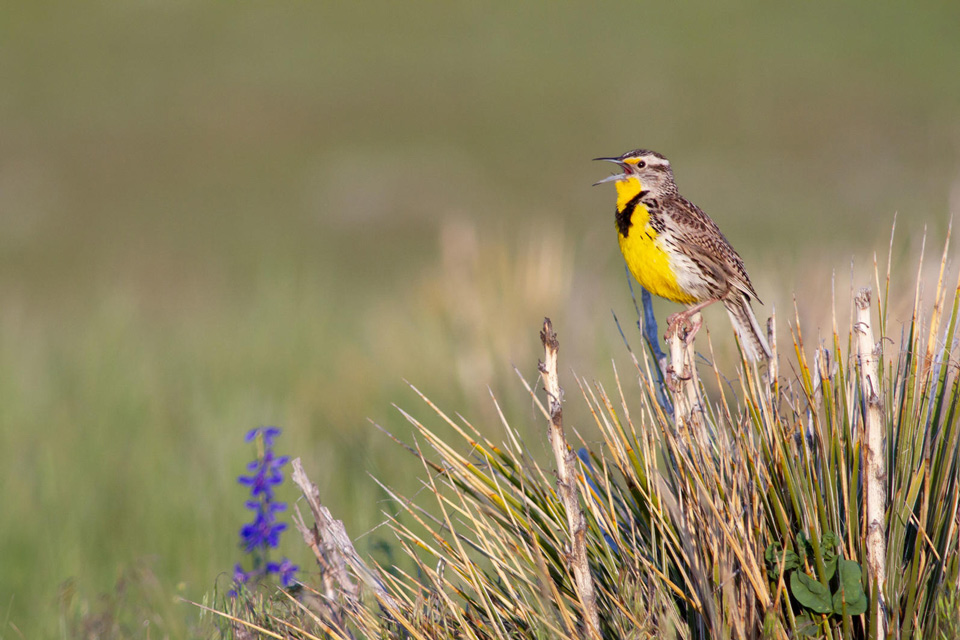
Western Meadowlark. Photo: Evan Barrientos/Audubon
Report affirms importance of programs like Audubon’s Conservation Ranching Initiative and findings of recent report on fate of birds in America’s grasslands.
August 11, 2019 - DALLAS — On Thursday, the IPCC released “Climate Change and Land,” a special report highlighting the connection between land use and climate change. The report calls for major changes in food production practices in order to reduce carbon emissions, increase the carbon sequestration potential of the soil, and protect biodiversity of landscapes.
“This UN report confirms what we’ve known at Audubon for a long time: farmers and ranchers are critical partners in protecting birds from climate change,” said Chris Wilson, director of Audubon’s Conservation Ranching Initiative.
“Luckily, ranchers are up to the task, as we’ve seen with regenerative grazing practices that can actually put carbon back into the soil while enhancing grassland bird habitat. Securing a future for ranchers and protecting birds from climate change are inextricably linked and one cannot happen without the other,” said Wilson.
Last month, the National Audubon Society published its North American Grasslands & Birds Report, a comprehensive analysis of climate change vulnerabilities and land-use threats facing grassland bird species dependent on the tallgrass, mixed grass, and shortgrass prairies in the United States and Canada as well as the Chihuahuan grasslands in Mexico.
Under the current carbon emissions scenario, nearly half (42 percent) of grassland bird species will become highly vulnerable by the end of this century. That number drops to one in twelve (8 percent) grassland bird species, if the emissions reductions surpass targets set by the Paris Climate Agreement.
“Each year more and more of North America’s grasslands and prairies disappear under the plow while our changing climate will only further squeeze the birds of this misunderstood landscape,” said Brian Trusty, vice president of the Central Flyway for National Audubon Society.
“The good news is that we know exactly where we need to focus, who we need to work with, and how we can save this irreplaceable and quickly vanishing ecosystem,” said Trusty.
To help prioritize conservation action across this imperiled ecosystem, the report identifies “climate strongholds” in North America that will provide the best habitat for declining grassland birds under all climate change scenarios and ongoing land conversion.
“Protecting and restoring habitats like the grasslands is key to the survival of birds, and the land itself,” said Dr. Chad Wilsey, vice president of conservation science for Audubon and lead author of the North American Grasslands & Birds Report.
“The survival of birds foreshadows the health of their habitats, as well as the people and other wildlife who depend on the land,” said Wilsey.
Furthermore, the report identifies Grassland Climate and Land-use Strongholds (GCLUs), key regions within North American grasslands that would retain climate suitability in all three climate scenarios as well as high land use suitability for grassland birds, based on 21st-century land-use change projections. The report also identified Vulnerable Grassland Climate Strongholds (VGCSs) as areas with high climate suitability but high risk of conversion to unsuitable land uses (e.g. croplands, urban areas, bare ground or forests). These categorizations can be used to inform and guide conservation efforts.
“Grassland birds are down but they’re not out, and by working together with ranchers, we’re going to give them the best possible chance to succeed,” said Trusty.
To learn more about the findings and recommendations in Audubon's North American Grasslands & Birds Report, please read the executive summary here.
About Audubon
The National Audubon Society protects birds and the places they need, today and tomorrow, throughout the Americas using science, advocacy, education and on-the-ground conservation. Audubon's state programs, nature centers, chapters and partners have an unparalleled wingspan that reaches millions of people each year to inform, inspire and unite diverse communities in conservation action. Since 1905, Audubon's vision has been a world in which people and wildlife thrive. Audubon is a nonprofit conservation organization. Learn more how to help at www.audubon.org and follow us on Twitter and Instagram at @audubonsociety.
[1] Wilsey, C., L. Taylor, B. Bateman, C. Jensen, N. Michel, A. Panjabi, and G. Langham (2019). Climate policy action needed to reduce vulnerability of conservation-reliant grassland birds in North America. Conservation Science and Practice
[2] Grand, J., C. Wilsey, J. X. Wu, and N. L. Michel (2019). The future of North American grassland birds: Incorporating persistent and emergent threats into full annual cycle conservation priorities. Conservation Science and Practice
Source: National Audubon Society








